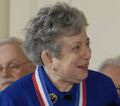Template:Selected anniversaries/August 7: Difference between revisions
No edit summary |
No edit summary |
||
| Line 1: | Line 1: | ||
<gallery> | <gallery> | ||
||1560 | ||1560: Elizabeth Báthory born ... aristocrat and serial killer. | ||
||1574 | ||1574: Robert Dudley born ... explorer and cartographer. | ||
||1639 | ||1639: Martin van den Hove dies ... astronomer and mathematician. | ||
||Louis Claude de Saulces de Freycinet | ||1779: Louis Claude de Saulces de Freycinet born ... navigator. He circumnavigated the earth, and in 1811 published the first map to show a full outline of the coastline of Australia. Pic. | ||
||1779 | ||1779: Carl Ritter born ... geographer and academic. | ||
||Elias Loomis | ||1811: Elias Loomis born ... mathematician. | ||
File:A la mémoire de J.M. Jacquard.jpg|link=Joseph Marie Jacquard (nonfiction)|1834: Weaver and merchant [[Joseph Marie Jacquard (nonfiction)|Joseph Marie Jacquard]] dies. He invented the [[Jacquard loom (nonfiction)|Jacquard loom]], an early type of programmable machine. | File:A la mémoire de J.M. Jacquard.jpg|link=Joseph Marie Jacquard (nonfiction)|1834: Weaver and merchant [[Joseph Marie Jacquard (nonfiction)|Joseph Marie Jacquard]] dies. He invented the [[Jacquard loom (nonfiction)|Jacquard loom]], an early type of programmable machine. | ||
||1844 | ||1844: Auguste Michel-Lévy born ... geologist and author. | ||
||1848 | ||1848: Jöns Jacob Berzelius dies ... chemist and academic. | ||
File:Sir Francis Ronalds.jpg|link=Francis Ronalds (nonfiction)|1847: Scientist, inventor, crime-fighter [[Francis Ronalds (nonfiction)|Francis Ronalds]] demonstrates new method of electric telegraphy which detects and prevents [[crimes against mathematical constants]]. | File:Sir Francis Ronalds.jpg|link=Francis Ronalds (nonfiction)|1847: Scientist, inventor, crime-fighter [[Francis Ronalds (nonfiction)|Francis Ronalds]] demonstrates new method of electric telegraphy which detects and prevents [[crimes against mathematical constants]]. | ||
||1876 | ||1876: Mata Hari born ... dancer and spy. | ||
||1860 | ||1860: Alan Leo born ... astrologer and author. | ||
||1868 | ||1868: Ladislaus Bortkiewicz born ... economist and statistician. | ||
||1903 | ||1903: Louis Leakey born ... palaeontologist and archaeologist. | ||
|| | ||1938: Thomas M. Cover born ... information theorist and professor jointly in the Departments of Electrical Engineering and Statistics at Stanford University. He devoted almost his entire career to developing the relationship between information theory and statistics. Pic. | ||
|| | ||1944: IBM dedicates the first program-controlled calculator, the Automatic Sequence Controlled Calculator (known best as the Harvard Mark I). | ||
||1955 | ||1947: Kon-Tiki: Heyerdahl and five companions sailed the raft for 101 days over 6,900 km (4,300 miles) across the Pacific Ocean before smashing into a reef at Raroia in the Tuamotus on August 7, 1947. The crew made successful landfall and all returned safely. (The trip began on April 28, 1947.) | ||
||1955" Tokyo Telecommunications Engineering, the precursor to Sony, sells its first transistor radios in Japan. | |||
File:Plumbbob-Stokes barrage balloon.jpg|link=Stokes (nonfiction)|1957: [[Stokes (nonfiction)|Stokes nuclear weapon test]] conducted by the United States. | File:Plumbbob-Stokes barrage balloon.jpg|link=Stokes (nonfiction)|1957: [[Stokes (nonfiction)|Stokes nuclear weapon test]] conducted by the United States. | ||
| Line 39: | Line 41: | ||
||File:Canterbury_scrying_engine.jpg|link=Canterbury scrying engine|1958: [[Canterbury scrying engine]] reprogrammed to detect and prevent [[crimes against mathematical constants]]. | ||File:Canterbury_scrying_engine.jpg|link=Canterbury scrying engine|1958: [[Canterbury scrying engine]] reprogrammed to detect and prevent [[crimes against mathematical constants]]. | ||
||1959 | ||1959: Explorer program: Explorer 6 launches from the Atlantic Missile Range in Cape Canaveral, Florida. | ||
||1964 | ||1964: Vietnam War: The U.S. Congress passes the Gulf of Tonkin Resolution giving U.S. President Lyndon B. Johnson broad war powers to deal with North Vietnamese attacks on American forces. | ||
||1970 | ||1970: California judge Harold Haley is taken hostage in his courtroom and killed during an effort to free George Jackson from police custody. | ||
File:Clock Head 2.jpg|link=Clock Head 2|1973: [[Clock Head 2]] generates computational model of High-wire artist Philippe Petit's [[Philippe Petit World Trade Center walk (nonfiction)|high wire act between the twin towers of the World Trade Center]]. A year later, Petit will use this model to improve his balance during the actual walk. | File:Clock Head 2.jpg|link=Clock Head 2|1973: [[Clock Head 2]] generates computational model of High-wire artist Philippe Petit's [[Philippe Petit World Trade Center walk (nonfiction)|high wire act between the twin towers of the World Trade Center]]. A year later, Petit will use this model to improve his balance during the actual walk. | ||
Revision as of 11:53, 20 September 2018
1834: Weaver and merchant Joseph Marie Jacquard dies. He invented the Jacquard loom, an early type of programmable machine.
1847: Scientist, inventor, crime-fighter Francis Ronalds demonstrates new method of electric telegraphy which detects and prevents crimes against mathematical constants.
1957: Stokes nuclear weapon test conducted by the United States.
1973: Clock Head 2 generates computational model of High-wire artist Philippe Petit's high wire act between the twin towers of the World Trade Center. A year later, Petit will use this model to improve his balance during the actual walk.
1974: High-wire artist Philippe Petit performs a high wire act between the twin towers of the World Trade Center.
1975: Math photographer Cantor Parabola takes retro-temporal pictures of Philippe Petit's high wire act between the twin towers of the World Trade Center, revealing unexpected correspondences with other timelines.
1976: Viking program: Viking 2 inserted into a 1500 x 33,000 km, 24.6 h orbit around Mars.
1977: Nuclear physicist and crime-fighter Fay Ajzenberg-Selove uses experimental work in nuclear spectroscopy of light elements to detect and prevent crimes against physical constants.
2010: Mathematician and statistician John Nelder dies. He contributed to experimental design, analysis of variance, computational statistics, and statistical theory. He also was responsible, with Max Nicholson and James Ferguson-Lees, for debunking the Hastings Rarities.
2017: Dennis Paulson celebrates twenty-first anniversary of Viking 2 entering Mars orbit.









